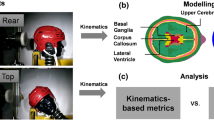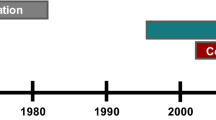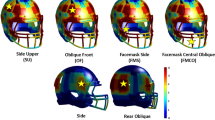Abstract
A method of investigating head acceleration and intracranial dynamics from stick impacts in girls’ and women’s lacrosse was developed using headform impact experiments and a finite element head model. Assessing the likelihood of head injury due to stick-head impacts is of interest in girls’ and women’s lacrosse due to the current lack of head protection during play. Experimental and simulation data were compared to characterize the head acceleration caused by stick-head impacts. Validation against cadaver head impact experiments ensures that the finite element model, with its relatively simple material properties, can provide means to develop a better understanding of the intracranial dynamics during lacrosse stick impacts. Our numerical results showed the peak acceleration at the center of gravity increased linearly with impact force, and was generally in agreement with the experimental data. von Mises stresses and peak principal strains, two common literature injury indicators, were examined within the finite element model, and peak values were below the previously reported thresholds for mild traumatic brain injury. By reconstructing typical in-game, unprotected stick-head impacts, this investigation lays the foundation for a quantitative methodology of injury prediction in girls’ and womens’ lacrosse.










Similar content being viewed by others
References
Beckwith, J. G., R. M. Greenwald, and J. J. Chu. Measuring head kinematics in football: correlation between the head impact telemetry system and Hybrid III headform. Ann. Biomed. Eng. 40:237–248, 2012.
Bower, A. F. Applied Mechanics of Solids. Boca Raton: CRC Press, p. 820, 2010.
Chafi, M. S., G. Karami, and M. Ziejewski. Biomechanical assessment of brain dynamic responses due to blast pressure waves. Ann. Biomed. Eng. 38:490–504, 2010.
Chatelin, S., C. Deck, F. Renard, S. Kremer, C. Heinrich, J.-P. Armspach, and R. Willinger. Computation of axonal elongation in head trauma finite element simulation. J. Mech. Behav. Biomed. Mater. 4:1905–1919, 2011.
Claessens, M., F. Sauren, and J. Wismans. Modeling of the human head under impact conditions: a parametric study. SAE Technical Paper 973338, 1997.
Cormier, J., S. Manoogian, J. Bisplinghoff, S. Rowson, A. Santago, C. McNally, S. Duma, and J. Bolte IV. The tolerance of the frontal bone to blunt impact. J. Biomech. Eng. 133:021004, 2011.
Crisco, J. J., R. Fiore, J. G. Beckwith, J. J. Chu, P. G. Brolinson, S. Duma, T. W. McAllister, A.-C. Duhaime, and R. M. Greenwald. Frequency and location of head impact exposures in individual collegiate football players. J. Athl. Train. 45:549–559, 2010.
Deck, C., and R. Willinger. Improved head injury criteria based on head FE model. Int. J. Crashworthiness 13:667–678, 2008.
Dillon, P., and R. Seewald. 2014 and 2015 NCAA Women’s Lacrosse Rules and Interpretations. National Collegiate Athletic Association, 2013.
Elkin, B. S., and B. Morrison. Region-specific tolerance criteria for the living brain. Stapp Car Crash J. 51:127–138, 2007.
Horgan, T. J., and M. D. Gilchrist. Influence of FE model variability in predicting brain motion and intracranial pressure changes in head impact simulations. Int. J. Crashworthiness 9:401–418, 2004.
Irick, E. 1981-82 - 2012-13 NCAA Sports Sponsorship and Participation Rates Report. National Collegiate Athletic Association, 2013.
Ji, S., H. Ghadyani, R. P. Bolander, J. G. Beckwith, J. C. Ford, T. W. McAllister, L. A. Flashman, K. D. Paulsen, K. Ernstrom, S. Jain, R. Raman, L. Zhang, and R. M. Greenwald. Parametric comparisons of intracranial mechanical responses from three validated finite element models of the human head. Ann. Biomed. Eng. 42(1):11–24, 2013.
Karlin, A. M. Concussion in the pediatric and adolescent population: “different population, different concerns”. PM&R 3:S369–S379, 2011.
Kleiven, S. Predictors for traumatic brain injuries evaluated through accident reconstructions. Stapp Car Crash J. 51:81–114, 2007.
Kleiven, S., and H. von Holst. Consequences of head size following trauma to the human head. J. Biomech. 35:153–160, 2002.
Kraft, R. H., P. J. McKee, A. M. Dagro, and S. T. Grafton. Combining the finite element method with structural connectome-based analysis for modeling neurotrauma: connectome neurotrauma mechanics. PLoS Comput. Biol. 8:e1002619, 2012.
Langlois, J. A., W. Rutland-Brown, and M. M. Wald. The epidemiology and impact of traumatic brain injury: a brief overview. J. Head Trauma Rehabil. 21:375–378, 2006.
Lincoln, A. E., R. Y. Hinton, J. L. Almquist, S. L. Lager, and R. W. Dick. Head, face, and eye injuries in scholastic and collegiate lacrosse a 4-year prospective study. Am. J. Sports Med. 35:207–215, 2007.
Littlefield, D. L., and S. Kulathu. Simulation of human head response to impact loading using newly developed biofidelic material models for brain tissue. Stapp Car Crash J. 55:75–89, 2011.
Mao, H., X. Jin, L. Zhang, K. H. Yang, T. Igarashi, L. J. Noble-Haeusslein, and A. I. King. Finite element analysis of controlled cortical impact-induced cell loss. J. Neurotrauma 27:877–888, 2010.
Mao, H., L. Zhang, B. Jiang, V. V. Genthikatti, X. Jin, F. Zhu, R. Makwana, A. Gill, G. Jandir, A. Singh, and K. H. Yang. Development of a finite element human head model partially validated with thirty five experimental cases. J. Biomech. Eng. 135:111002, 2013.
McAllister, T. W., J. C. Ford, S. Ji, J. G. Beckwith, L. A. Flashman, K. Paulsen, and R. M. Greenwald. Maximum principal strain and strain rate associated with concussion diagnosis correlates with changes in corpus callosum white matter indices. Ann. Biomed. Eng. 40:127–140, 2012.
McCrory, P., W. Meeuwisse, K. Johnston, J. Dvorak, M. Aubry, M. Molloy, and R. Cantu. Consensus statement on concussion in sport: the 3rd international conference on concussion in sport held in Zurich, November 2008. Br. J. Sports Med. 43:i76–i84, 2009.
Meaney, D. F., B. Morrison, and C. Dale Bass. The mechanics of traumatic brain injury: a review of what we know and what we need to know for reducing its societal burden. J. Biomech. Eng. 136:021008-1–021008-14, 2014.
Mihalik, J. P., K. M. Guskiewicz, S. W. Marshall, J. T. Blackburn, R. C. Cantu, and R. M. Greenwald. Head impact biomechanics in youth hockey: comparisons across playing position, event types, and impact locations. Ann. Biomed. Eng. 40:141–149, 2012.
Miller, R. T., S. S. Margulies, M. Leoni, M. Nonaka, X. Chen, D. H. Smith, and D. F. Meaney. Finite element modeling approaches for predicting injury in an experimental model of severe diffuse axonal injury. SAE Technical Paper 983154, 1998.
Moore, D. F., A. Jerusalem, M. Nyein, L. Noels, M. S. Jaffee, and R. A. Radovitzky. Computational biology—modeling of primary blast effects on the central nervous system. Neuroimage 47(Suppl 2):T10–T20, 2009.
Nahum, A. M., R. Smith, and C. C. Ward. Intracranial pressure dynamics during head impact. Proceedings of the 21st Stapp Car Crash Conference, SAE Paper No. 770922. Society of Automotive Engineers, Warrendale, PA. 1977.
Naunheim, R. S., J. Standeven, C. Richter, and L. M. Lewis. Comparison of impact data in hockey, football, and soccer. J. Trauma 48:938–941, 2000.
Nyein, M. K., A. M. Jason, L. Yu, C. M. Pita, J. D. Joannopoulos, D. F. Moore, and R. A. Radovitzky. In silico investigation of intracranial blast mitigation with relevance to military traumatic brain injury. Proc. Natl. Acad. Sci. USA 107:20703–20708, 2010.
Pellman, E. J., D. C. Viano, A. M. Tucker, I. R. Casson, and J. F. Waeckerle. Concussion in professional football: reconstruction of game impacts and injuries. Neurosurgery 53:799–812; discussion 812–814, 2003.
Raul, J.-S., D. Baumgartner, R. Willinger, and B. Ludes. Finite element modelling of human head injuries caused by a fall. Int. J. Leg. Med. 120:212–218, 2006.
Roth, S., J.-S. Raul, B. Ludes, and R. Willinger. Finite element analysis of impact and shaking inflicted to a child. Int. J. Leg. Med. 121:223–228, 2007.
Rowson, S., G. Brolinson, M. Goforth, D. Dietter, and S. Duma. Linear and angular head acceleration measurements in collegiate football. J. Biomech. Eng. 131:061016, 2009.
Ruan, J. S., T. Khalil, and A. I. King. Dynamic response of the human head to impact by three-dimensional finite element analysis. J. Biomech. Eng. 116:44–50, 1994.
Takhounts, E. G., R. H. Eppinger, J. Q. Campbell, R. E. Tannous, E. D. Power, and L. S. Shook. On the development of the SIMon finite element head model. Stapp Car Crash J. 47:107–133, 2003.
Takhounts, E. G., S. A. Ridella, V. Hasija, R. E. Tannous, J. Q. Campbell, D. Malone, K. Danelson, J. Stitzel, S. Rowson, and S. Duma. Investigation of traumatic brain injuries using the next generation of simulated injury monitor (SIMon) finite element head model. Stapp Car Crash J. 52:1–31, 2008.
Willinger, R., H. S. Kang, and B. Diaw. Three-dimensional human head finite-element model validation against two experimental impacts. Ann. Biomed. Eng. 27:403–410, 1999.
Willinger, R., L. Taleb, and C. M. Kopp. Modal and temporal analysis of head mathematical models. J. Neurotrauma 12:743–754, 1995.
Wright, R. M., A. Post, B. Hoshizaki, and K. T. Ramesh. A multiscale computational approach to estimating axonal damage under inertial loading of the head. J. Neurotrauma 30:102–118, 2013.
Yao, J., J. Yang, and D. Otte. Investigation of head injuries by reconstructions of real-world vehicle-vs.-adult-pedestrian accidents. Saf. Sci. 46:1103–1114, 2008.
Young, P. G., T. B. H. Beresford-West, S. R. L. Coward, B. Notarberardino, B. Walker, and A. Abdul-Aziz. An efficient approach to converting three-dimensional image data into highly accurate computational models. Philos. Trans. R. Soc. A 366:3155–3173, 2008.
Acknowledgments
This study was funded in part by US Lacrosse, the National Operating Committee on Standards for Athletic Equipment (NOCSAE), and the Rhode Island Science and Technology Advisory Council. We would also like to thank Laura Costa for her efforts in performing the impact experiments.
Conflict of interest
The authors have no financial interests associated with this study.
Author information
Authors and Affiliations
Corresponding author
Additional information
Associate Editor Stefan M Duma oversaw the review of this article.
Rights and permissions
About this article
Cite this article
Morse, J.D., Franck, J.A., Wilcox, B.J. et al. An Experimental and Numerical Investigation of Head Dynamics Due to Stick Impacts in Girls’ Lacrosse. Ann Biomed Eng 42, 2501–2511 (2014). https://doi.org/10.1007/s10439-014-1091-8
Received:
Accepted:
Published:
Issue Date:
DOI: https://doi.org/10.1007/s10439-014-1091-8




